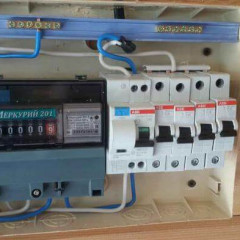Advantages and disadvantages of dual tariff meters
Principle of operation
The principle of operation of the two-tariff meter is that at different times of the day the cost of 1 kW of electricity will differ. At night, a kilowatt hour costs less than during the day.
What is it for? First of all, electric substations that generate electricity are interested in this. As a rule, in the morning (from 7 a.m. to 10 a.m.) and in the evening (7-11 a.m.), the load on the substation is rapidly increasing due to increased electricity consumption by enterprises and ordinary consumers. As a result, the substation has to work unevenly, which entails rapid wear of equipment and uneven consumption of fuel (gas, oil or coal). In order to somehow reduce the peak hours of consumption, two-tariff electricity meters were introduced.
Such devices work as follows: in the daytime (from 07.00 to 23.00), the cost of electricity is slightly higher than when using conventional devices, but at night (from 23.00 to 07.00) the second tariff is used - a reduced rate, when one kW of electricity costs several times less.
Thus, this event encourages consumers to use some powerful electrical appliances at night, so that both people save their money and the substation saves their material costs.
Benefits
The main advantages of a two-tariff electricity meter are:
- Saving own funds (the payback of the meter is about 1 year).
- Assistance in the operation of the power plant (electricity producers will less often repair equipment and save fuel on electricity generation).
- Reduction of harmful emissions into the atmosphere. As we have already said, due to the uneven consumption of electricity, the station sporadically consumes fuel, so harmful emissions will pollute the environment intensively in the afternoon and late afternoon.
As a rule, the last two points are not so important for ordinary consumers, so we can highlight the main advantage of two-tariff electricity meters - cost savings.
disadvantages
Despite its advantages, the meter for two tariffs has disadvantages, namely:
- Far from all regions, the day and night cost of a kilowatt-hour of electricity is beneficial for consumers. In some cities, the following trend is observed: during the day, 1 kWh is almost 2 times more expensive than using single-rate metering, and at the same time, the price of nightly consumption is only 15-20% lower.
- After installing the two-tariff meter, it is necessary to use household appliances correctly, otherwise there will be no talk of any savings.
Here I would like to talk more about the second paragraph. The fact is that it is beneficial to use the counter for two tariffs only according to the following principle:
In every house and apartment there are powerful electrical appliances that you do not have to use during the day: washing and dishwasher, air conditioning, heater, etc. If you wash things and wash dishes after 23.00 (turn on the device before bedtime), then in this mode of operation you can significantly save money. Otherwise (during daily switching), the cost of paying for electricity will only increase.
Owner reviews
We got acquainted with the advantages and disadvantages of two-tariff meters, now I would like to provide feedback that we found on some forums.
To enlarge the picture, click on it!
Positive reviews:
That, in fact, was all I wanted to say about whether to buy this meter. As you can see, the electricity meter for two tariffs has both pros and cons, so if you still haven't decided whether to make a purchase or not, read more reviews about the operation of your chosen two-tariff meter model. Consumer opinions will help you compare the pros and cons of the two-tariff electricity metering devices.
Similar materials:













It really saves two tariff meters, only if one lives, or the family consists of two people, it seems to me that the sheepskin is not worth the cost.
I live alone a month, I consume 60-80 kW. I paid 80 kW on a single-rate meter. * 0.90 = 72 UAH, and on a 2-tariff counter, I pay 12 UAH more at the expense of interest rate! (day 70, night 10, i.e. 87.5% during the day, 12.5% at night). cost during the day 87.5 * 0.9 = 78.75 UAH, cost at night 12.5 * 0.45 = 5.62 UAH. Only 78.75 + 5.62 = 84.4 UAH. RESUME 12 hryvnia !!!!!! Here you have the savings !!!! Who consumes little electricity categorically can not put 2-zone meters !!!!!!
Those who use electricity more in the daytime are not profitable for the two-tariff meter.
Why do you have such a count? And then the percentage? You have a daily consumption of 70 kW * 0.9 = 63 grivnas and at night 10 kW * 0.45 = 4.5 grivnas. Total 67.5 hryvnia. Savings4.5 hryvnia. Another thing is that with such a small expense will pay off for a very long time.
It does not save anything, all needs occur in the morning, in the afternoon, air conditioning is needed in the afternoon, vacuuming also in the afternoon, because at night the neighbors are indignant, as a result, we get a daily rate, when you still do everything more than usual, and at night when normal people sleep with you benefit, good benefit ... You can’t deceive these power grids, they will heat anyone you want ...
A two-rate meter costs about 3 years. I wash at night, put the machine on the timer, in the near future a dishwasher, of course, also at night. In addition, we often sit up until 2 and 3 nights, a computer, two televisions, two refrigerators are working.
You just need to correctly use it. There are families that go to bed early, so I think it is not profitable.